Vietnam
![]()
The title of this article is ambiguous. For other meanings, see Vietnam (disambiguation).
Template:Infobox State/Maintenance/NAME-German
Vietnam ([vi̯ɛtˈna[ː]m], Vietnamese Việt Nam [in Hanoi viɜʔt̚˧ˀ˨ʔ naːm˧˧], meaning "Viet of the South", officially Socialist Republic of Vietnam, Vietnamese Cộng hòa Xã hội chủ nghĩa Việt Nam, Chữ Nôm 共和社會主義越南 [in Hanoi kɜwŋ͡m˧ˀ˨ʔ hwaː˨˩ s̪aː˦ˀ˥ hoj˧ˀ˨ʔ ṯɕu˧˩ ŋiɜ˦ˀ˥ viɜʔt̚˧ˀ˨ʔ naːm˧˧]) is an elongated coastal state in Southeast Asia. It borders China, Laos, Cambodia, the Gulf of Thailand, and the South China Sea.
The first historically attested kingdom on the territory of present-day Vietnam emerged in the 1st millennium B.C. Thereafter, peaceful coexistence developed between the Yues and the Han during the Trieu Dynasty. In 111 B.C., the dynasty came under the control of the Han Chinese as a province of the Han Dynasty and remained so - interrupted by brief periods of independence - until 938 A.D., when it gained independence after the Battle of the Bạch Đằng River. This was followed by a flourishing period of culture, society, economy and politics. In the following centuries, Vietnam expanded southward. In the 19th century, the area gradually came under French colonial rule as part of French Indochina.
During the Second World War, Japan occupied the region. From 1946 to 1954, France tried unsuccessfully to restore its colonial rule in the First Indochina War. As a result of the French defeat, in 1954 Tonkin and the northern part of Annam became the socialist North Vietnam with its capital in Hanoi, and Cochinchina and the southern part of Annam became the Western-backed South Vietnam with its capital in Saigon. From 1964 to 1973, the United States of America failed to defeat North Vietnam and its allied National Front for the Liberation of South Vietnam in the Vietnam War. Instead, the two Vietnamese states were reunified in 1976 under communist leadership. Market reforms have been under way since 1986 under the Đổi mới, but so far they have led only to rudimentary political liberalization. Hanoi became the capital of reunified Vietnam in 1976; the largest city by population is Ho Chi Minh City (Saigon); Haiphong, Cần Thơ and Đà Nẵng are also important metropolises in the country.
Geography
→ Main article: Geography of Vietnam
Vietnam's area corresponds to about 93% of that of Germany. The country encompasses the vast plains of the Red River and Mekong River deltas, the entire eastern mainland coast of Southeast Asia, and the long mountain ranges and plateaus of the hinterland. The north-south extent is about 1650 km, the east-west width up to 600 km, while the narrowest point in central Vietnam is only 50 km wide.
The geography of Vietnam is also described as a "bamboo pole with two rice bowls": In the north and south lie two fertile rice-producing river deltas, with a narrow, rather barren area of forest and mountains in between as a link. In total, three quarters of Vietnam is covered by mountains and plateaus.
Landscapes
Five landscapes are distinguished from north to south:
- Yunnan Highlands: Mountainous region in the north where Vietnam borders China and its highest mountain is Phan-xi-păng (3144 m). This region is the settlement area of many ethnic minorities, with the town of Sa Pa at the foot of Phan-xi-păng attracting the most tourists.
- Red River Delta: This fertile area around the capital Hanoi (Hà Nội) extends to the Gulf of Tonkin (Bắc Bộ). Tourist attractions here are the limestone cliffs around Ninh Bình south of Hanoi, and Halong Bay east of the capital.
- Annamite highlands: The mountainous, sparsely populated hinterland of central and southern Vietnam is mainly a settlement area for ethnic minorities.
- Annamite coastal strip: the narrow, relatively densely populated coastal area between the mountains and the South China Sea in central and southern Vietnam. Annam's largest cities are Huế and Đà Nẵng.
- Mekong Delta: fertile, densely populated alluvial plain, on the north-eastern edge of which lies the megacity of Ho Chi Minh City (Thành phố Hồ Chí Minh, until 1976 Saigon).
Climate
The climate differs significantly between northern and southern Vietnam. The north has a temperate tropical alternating climate, with a cool season from November to April and a hot season from May to October. The south is tropical: warm to very hot throughout the year, slightly cooler from November to January, hot from February to May, and with a rainy season between May and October. The weather divide between these areas is the Cloud Pass north of Đà Nẵng.
During the rainy season typhoons often rage, which can cause flooding especially in the Mekong Delta, but also in other coastal regions.
Wildlife
Vietnam has a species-rich animal kingdom, which is, however, threatened by the progressive destruction of the forests and poaching. According to recent estimates, there are only about 200 tigers and less than 60 Asian elephants living there, whose survival is questionable. The Java rhinos, long restricted to the area of the Cat Tien National Park in Vietnam, were already wiped out by poaching in 2010. Outside Vietnam, the rare animals now live only in Ujung Kulon National Park on the island of Java. Other mammals include primates (crested gibbons, plumploris, langurs, macaques), predators (including Malayan bears, marbled cats and several species of creeping cats), cloven-hoofed animals (cantchile, muntjac, deer, bantengrinder, gaure) and numerous species of bats and rodents. The bird life is also rich in species, including pheasants, hornbills, owls, birds of prey, herons and numerous songbirds. It is also home to crocodiles, snakes, lizards and frogs, as well as countless species of insects and invertebrates. In the 1990s, several new species of Vietnamese were described, including the Vu-Quang cattle and several species of muntjac. The Vu Quang cattle are protected in the Vu Quang National Park.
Environment
The use of environmental toxins by the USA during the Vietnam War has caused lasting damage to Vietnamese nature. In particular, dioxin-containing herbicides such as Agent Orange, of which the US Air Force sprayed more than 45 million litres over the country, continue to have an effect in large areas of land, as they decompose only very slowly and have a half-life of about a decade. Thus, during the war, about half of the mangrove swamps were destroyed, unable to regenerate themselves. The defoliated slopes in the interior still cannot be reforested because only very hardy grasses can survive, and they are very susceptible to wildfires during the dry season. In the rainy season, therefore, there is extremely severe erosion in these regions.
It is not only those who came into direct contact with dioxins at the time (skin burns, chloracne, cancer) who are still suffering from the long-term effects of their use. The poison also found its way into the food chain, which leads to significantly increased numbers of miscarriages, stillbirths and birth defects, among other things, due to the resulting damage to genetic material.
In addition to environmental toxins, a large number of unexploded ordnance and landmines can still be found in rural areas. Every year, farmers and scrap metal seekers continue to be killed or injured by exploding munitions.
Millions of hectares of tropical forests, which had already suffered from herbicides, have been destroyed by slash-and-burn and deforestation since the 1960s. Particularly affected by this is the north, which is sometimes difficult to access. Although the government is trying to put a stop to this, the pressure of the rapidly growing population and the poverty in the mountain provinces is causing the population to burn down forests again and again in order to gain arable land. Tropical woods such as teak are still illegally extracted in Vietnam, as in the whole of Southeast Asia, despite now strict legal regulations, to make furniture for the European, US and Japanese markets.
There are programmes, some with large amounts of foreign aid, to strengthen the environmental awareness of the Vietnamese. The government and environmental organisations have high hopes for the development of ecotourism. They have already established several national parks - the oldest of them as early as 1962 - and some of the country's landscapes are under special protection by UNESCO.
Management structure
→ Main article: Administrative division of Vietnam
Vietnam is divided into 58 provinces and five municipalities. Below this level follow cities, districts and villages. The people's councils of the provinces and municipalities are directly subordinate to the central government. At the district and municipal levels, there are also elected People's Councils, to which local authorities are bound to a certain extent. The People's Councils also elect the People's Committees, which are the regional governments.
Cities
The two most important cities by far are the capital Hanoi (Hà Nội) and Vietnam's largest city Ho Chi Minh City (Thành phố Hồ Chí Minh, formerly Saigon). While the latter is one of the fastest growing boom cities in the world and is understood to be the economic centre of ASEAN, Hà Nội has a reputation for being quieter and more elegant. In fact, Hà Nội is quite far behind the southern metropolis in economic terms.
The port cities of Đà Nẵng, HảiPhòng and Nha Trang have a strong French influence in their townscape. This can be seen, among other things, in the churches and villas of the cities. The cities of Huế as the capital during the last imperial dynasty and the imperial summer residence Đà Lạt in the southern highlands are of great historical importance and attract many visitors. The trading town of Hội An is also interesting for tourists, as its old town, declared a UNESCO World Heritage Site, is very well preserved. Purely industrial cities, on the other hand, are Vinh, Ninh Bình, Mỹ Tho or Bến Tre.
The entire coast is dotted with beaches, some of which are undeveloped for tourism. Examples are Mũi Né, Long Hải and Vũng Tàu on the South China Sea and Hà Tiên on or Phú Quốc Island in the Gulf of Thailand.
In 2016, 34.2% of the population lived in cities or urban areas. The 5 largest cities are (as of 2016):
- Ho Chi Minh City: 6,642,000 inhabitants
- Hanoi: 3,442,000 inhabitants
- Da Nang: 915,000 inhabitants
- Hai Phong: 842,000 inhabitants
- Bien Hoa: 821,000 inhabitants
See also: List of cities in Vietnam
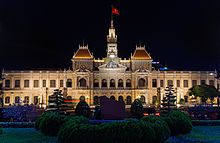
Colonial style city hall of Hồ-Chí-Minh City
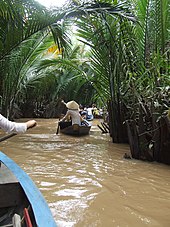
Mekong Delta
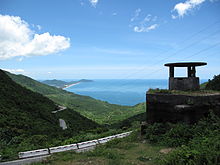
Hai Van Pass (Cloud Pass)
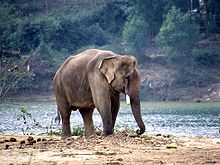
Working elephant on the bank of the Perfume River in Central Vietnam
Population
Demographics
Vietnam had an estimated population of 96.5 million in 2019. The population is very young on average: nationwide, about 32% of people were under 14 years old in 2005 and only about 5.6% are over 65. Population growth is estimated at 1.3% to 1.4%. The birth rate is tending to decrease (2005: 17.07 births per 1000 and 1.94 children per woman), while due to improved medical conditions the death rate is also decreasing (2005: 6.2 per 1000). Life expectancy in the period from 2010 to 2015 was 75.7 years overall (70.7 years for men and 80.3 years for women).
While the Vietnamese population is perceived by Western observers as consistently young, Vietnam is beginning to adjust to the fact that the population has entered a phase of aging. As of April 1, 2010, the number of people over the age of 60 reached 8.1 million, representing 9.4% of the total population and a 4% increase over 2009, making Vietnam one of the countries with an exceptionally rapid aging of the total population. While it took 85 years in Sweden, 26 years in Japan and 22 years in Thailand to reach aging population status according to United Nations Population Fund (UNFPA) guidelines, it took only 20 years in Vietnam. The rapid aging of the population is due to the fact that the fertility rate has declined from over 5 children per woman in the 1970s to 2.0 children today.
The majority of the population lives in the densely populated areas of the Red River and Mekong estuaries, where agriculture predominates. Despite the agricultural character, around 34 % of the Vietnamese already lived in the urban regions of the large cities in 2016 (in the 1980s it was only 15 %), and immigration from the economically less developed rural areas is constantly increasing. In addition, there is a migration movement from the north towards the south. In Vietnam there is no private ownership of land. The Vietnamese state grants land use rights with an average approved useful life of around 50 years.
Nearly 2.5 million live abroad, most of whom fled during the Vietnam War or were forced to leave the country due to political persecution. Just under 1.3 million of them live in the United States and 125,000 in the former colonial power France. Remittances from Vietnamese in exile are an extremely important source of income for relatives back home. In Vietnam itself, only 0.1% of the inhabitants are foreign-born, making the country one of the most homogeneous in the world.
Development of the population over time
| Year | Population | Year | Population |
| 1950 | 24.810.000 | 1990 | 68.210.000 |
| 1955 | 28.148.000 | 1995 | 75.199.000 |
| 1960 | 32.671.000 | 2000 | 80.286.000 |
| 1965 | 37.860.000 | 2005 | 84.309.000 |
| 1970 | 43.407.000 | 2010 | 88.473.000 |
| 1975 | 48.729.000 | 2019 | 96.462.000 |
| 1980 | 54.373.000 | 2030 | 106.284.000 |
| 1985 | 61.049.000 | 2050 | 114.630.000 |
Source: UN, figures for 2030 and 2050 are forecasts
Peoples
→ Main article: Peoples of Vietnam
About 88% of the population are ethnic Vietnamese (Việt or Kinh). In addition, 53 ethnic minority groups are recognised. The largest of these are the "overseas Chinese" (Vietnamese: Hoa), estimated at about 1.2 million. The majority of them are descendants of immigrants who came to the country in 1644, after the collapse of the Ming Dynasty. Other ethnic groups include Thái, Khmer (especially in the south, the Mekong Delta region, which for centuries belonged to Cambodia), and the inhabitants of the mountainous regions known collectively as Montagnards ("hill tribes"). The latter, who are considered the original inhabitants of continental Southeast Asia, were displaced in the course of history in Vietnam, Thailand, Myanmar and Laos by the immigrant majority peoples from the more fertile regions of the river plains and coasts to the inaccessible mountain regions.
Since some members of the "hill tribes" fought on the side of France and the USA respectively in the Indochina War and the Vietnam War, there was repression against these peoples after the reunification of Vietnam and they are partly not well regarded in Vietnamese society. However, minority peoples who fought on the Vietnamese side also receive little positive attention. To this day, these peoples are largely cut off from the economic development of the country and live comparatively in poverty. The culture and language of the minorities are usually very different from those of the Vietnamese.
Languages
See also: Vietnamese language
The official language is Vietnamese, which 88% of the population speak as their mother tongue. The Vietnamese language has been written in its own Latin-based script since 1945. From the Vietnamese point of view, the numerous ethnic minorities are recognized, the languages of the minorities are allowed and also promoted.
The French language had gradually lost its official status after the French colonial period, but continues to be of high importance as it is taught as the first foreign language in many schools. Vietnam is also a full member of the Community of Francophone States. Many Vietnamese emigrated to France during the Indochina wars and form a French-speaking diaspora there. Russian - and to a lesser extent German, Czech and Polish - are spoken by many Vietnamese who studied or worked in Eastern bloc states during the Cold War. Meanwhile, Russian and French are being displaced from public and school life by English, due to the arrival of many tourists from Anglo-Saxon countries and increased trade with the former "arch-enemy" USA. Learning English is now compulsory in most schools, although French is still offered in some educational institutions.
Religion
See also: Protestantism in Vietnam and Roman Catholic Church in Vietnam
Precise information on religious affiliation in Vietnam is difficult to come by. The vast majority of Vietnamese do not profess any faith. According to a study published in 2004, 81.5 percent of the Vietnamese are atheists. Estimates put the number of Buddhists at around 20 million and Catholics at 6 million. Other denominations are Cao Dai (2 million adherents), Hoa Hao (1 million), Protestantism (500,000) and Islam (50,000). In the religious understanding of the Vietnamese there is no strict separation of different denominations. Religiosity is mostly a historically evolved mixture with many aspects of different religious origins. It is not uncommon for Vietnamese to regularly visit Buddhist pagodas and worship their ancestors.
Everyday religiosity - or rather the way of life - is generally most influenced by Theravada and Mahayana Buddhism, Taoism, Confucianism, as well as animistic ideas and especially an ancestor cult, without dogma. Belief in spirits is widespread. Ritual action elements of the different influences can appear with the individual depending upon everyday life situation. In the folk religions of Đạo Mẫu and Cao Đài, originally influenced by Confucianism, there are still urban shamans (Dong) who perform a variety of rituals of sacrifice and inspiration. Particularly popular among all Vietnamese regardless of their denomination is the Lên đồng ritual, in which the shaman asks the spirits in a trance for health and prosperity for the hosts of the ritual. The costume plays an important role in this: it mirrors the classical court costume of the pre-modern era and is "put on" the spirit to honor it in this way. The spirit then makes contact with those present through the medium to receive offerings and enjoy the music.
Unlike in other Asian states, in (South) Vietnam there has also existed since 1963 a central association of religious and lay people of all Buddhist schools, the "Congregation of the United Vietnamese Buddhist Church" (KVVBK).
Vietnam's constitution generally provides for freedom of religion or belief. However, since religious institutions always represent a certain competition to the state's influence on the population, religion and its institutions were treated with suspicion by the VietnameseCommunist Party, at least in the past.
The Catholic faith first came to the country in the 16th century with French, Spanish and Portuguese missionaries. It was spread under pressure from French colonial rule. After actively fighting Catholicism in the early years of communist rule, the government is now seeking a better relationship with the Holy See. The visit of then Prime Minister Nguyễn Tấn Dũng to Pope Benedict XVI in 2007 boosted hopes for a further opening towards greater religious freedom, but the Catholic Church is still seen as "reactionary".
Education
In 2000, it is estimated that 92% of all children were enrolled in school. However, only two thirds completed the five years of primary school. Especially in rural areas, many children leave school prematurely, the reasons being the cost of school materials, books and uniforms, and the need to earn money to support the family. Regionally, there are huge differences: In some rural areas, only 10-15% of children go to school for more than three years, while in Ho Chi Minh City, 96% of students finish the primary years. Only 62.5% of children start middle school. In Vietnam, the median length of schooling for those over 25 years old increased from 3.9 years in 1990 to 8 years in 2015. The current education expectancy is already 12.6 years.
About 6% of the population over the age of 15 is illiterate; illiteracy affects 3.7% of males and 7.2% of females, for an overall rate of 4.5% (as of 2015). There is no compulsory education in Vietnam. Since education has to be paid for by oneself and some families do not have enough money for it, they do not send their children to school. In the 2015 PISA ranking, Vietnamese students achieved 22nd place out of 72 countries in mathematics, 8th place in science and 30th place in reading comprehension. Vietnam thus achieved an exceptionally good result for a developing country.
Elementary school goes up to 5th grade, middle school up to 9th; then you have to pass an exam to get into high school (10th, 11th and 12th grade). If this is not passed, one remains seated again and again. This applies to Gymnasium and Realschule (provided you don't drop out).
If you attend a Gymnasium or a Realschule, you cannot and must not change.
There are state and private universities, the most prestigious of which are the Hà Nội State University and the Hồ-Chí-Minh City State University; admission is regulated by an entrance examination of the respective university. Since 2008, Hồ-Chí-Minh City has also been home to the Vietnamese-German University.
The most common foreign language in Vietnam today is English. For reasons related to the country's history and former integration into the Eastern Bloc, one often encounters people who speak French, Russian or German; for example, about 100,000 Vietnamese studied, worked or received training in the GDR. More and more Vietnamese are also learning Japanese and Chinese.
Healthcare
In 2001, the government spent 0.9 % of GDP on the health system. In 2000, there were 14.8 hospital beds per 10,000 inhabitants, which is a very low figure even for Asia. 80 % of all expenditures for the health system come from the patients themselves.
After diseases such as malaria, tuberculosis, dengue fever, typhoid and cholera were major problems in the 1980s and 1990s, Vietnam has accepted foreign aid and largely pushed back these epidemics. HIV prevalence was officially 0.35% in 2005, which is the global average. HIV/AIDS patients are socially ostracized, making it difficult to combat the epidemic effectively.
A health study from 2007 shows that 87% of Vietnamese in the 60-69 age group suffer from diseases. The rate of illness is even higher in the even older sections of the population.
After the numerous wars in Vietnam's past, 5 million Vietnamese or 6% of the population are disabled.
The proportion of undernourished population was reduced from 24.3% in 2000 to 10.7% in 2015.
| Development of life expectancy since 1950 | |||
| Period | Life expectancy in years | Period | Life expectancy in years |
| 1950–1955 | 53,5 | 1985–1985 | 69,8 |
| 1955–1960 | 57,3 | 1990–1990 | 71,2 |
| 1960–1965 | 60,5 | 1995–2000 | 72,7 |
| 1965–1970 | 62,3 | 2000–2005 | 73,8 |
| 1970–1975 | 57,8 | 2005–2010 | 74,7 |
| 1975–1980 | 66,1 | 2010–2015 | 75,6 |
| 1980–1985 | 68,1 | ||
Source: UN
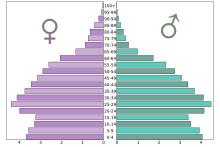
Age pyramid in millions of inhabitants
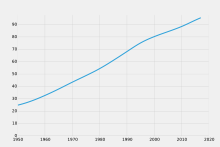
Population development in millions of inhabitants
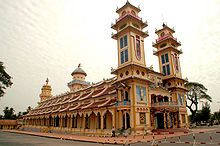
Cao Dai Temple in Tây Ninh
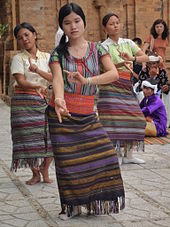
Dance of Cham women in front of their temple
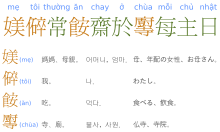
Orange: original Vietnamese words; green: Chinese-Vietnamese words
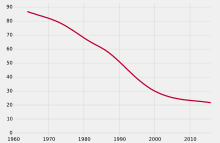
Trends in infant mortality (deaths per 1000 births)
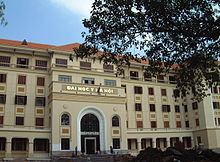
University of Medicine in Hanoi
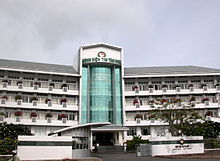
Tam Duc Hospital in Ho Chi Minh City
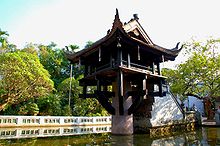
One Pillar Pagoda in Hanoi
Questions and Answers
Q: What is the full name of Vietnam?
A: The full name of Vietnam is the Socialist Republic of Vietnam.
Q: What countries border Vietnam?
A: The neighboring countries of Vietnam are China, Laos and Cambodia.
Q: Does Vietnam have a communist government?
A: Yes, Vietnam is one of five countries that still have a communist government.
Q: What is the capital city of Vietnam?
A: The capital city of Vietnam is Hanoi.
Q: When did Vietnamese independence occur?
A: Vietnamese independence occurred in 2 September 1945 when Hồ Chí Minh declared it under the new name of the Democratic Republic of Vietnam.
Q: How was the country divided after independence?
A: After Vietnamese independence, it was divided into two political states - North Vietnam (officially the Democratic Republic of Vietnam) and South Vietnam (officially the Republic of Vienam).
Q: When did economic reforms begin in Vietman?
A: Economic reforms began in 1986 when the government made many economic and political changes to become part of the world economy.
Search within the encyclopedia